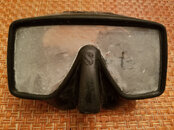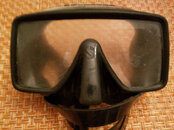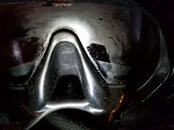Chasing down another rabbit-hole tonight.
While getting ready for second round of testing, I had an idea. Heat mask to max temp to release anything in the skirt while aggressively cleaning the glass surface with something that is acidic. No water, no solutions. But I want an acid treatment (see previous references).
Run-of-the-mill silicones can take 300F (150C) for extended periods, 350F for short times.
Aspirin melts at 275F and boils around 10 degrees higher. Aspirin it is. Ground up a tablet of Bayer Aspirin, exhaled on mask lens and dusted the lens:

Put the dusted mask into a cold oven and heated it to 290F (143C) for about ten minutes. Opened oven, cloud of white smoke.

Figured that I killed my mask. Not so! Just aspirin smoke. Quite a coating on the glass:

Neither water nor rubbing alcohol was effective in removing the film. However, Clorox spray and some rubbing finally removed it.
Interesting part of all this is that either side of the nose pocket shows a patch of glass that absolutely will not fog. This is what I am looking for:

Tomorrow: Aspirin dust, bake, remove the film with toothpaste. Nice part is, it is really easy to see what has to be removed and how good of a job you did at removing it...
Stay tuned.






